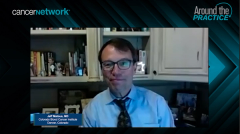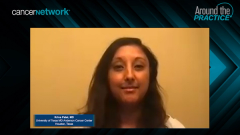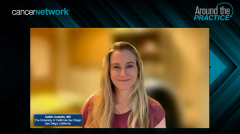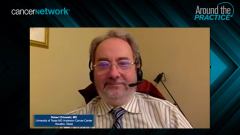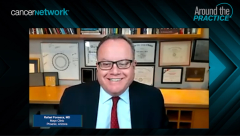
CAR-T Therapies in Relapsed/Refractory Multiple Myeloma: CARTITUDE-1 and KarMMA Studies
Key takeaways from the CARTITUDE-1 study and the KarMMA study evaluating CAR T-cell therapies for relapsed/refractory multiple myeloma.
Episodes in this series

Rafael Fonseca, MD: Dr Patel is chomping at the bit because she heard Dr Costello say, “Take a step back.” She’s going to say, “Take 2 steps back,” because now I want to talk about CARTITUDE-1. Let’s talk about response rates. What did we learn from CARTITUDE-1, Dr Patel?
Krina Patel, MD: We saw a 97.9% response rate and an 80% stringent CR [complete response] rate. Mic drop for that one. It’s like a frontline therapy. It’s like GRIFFIN, but it’s 6 lines in. These patients have had 6 lines of therapy and a 1-time cell dose. They get their lymphodepletion. They get their cell dose, which, for this CAR [chimeric antigen receptor] T product, is a lower cell dose because they have their 2 BCMA epitopes in that llama cartridge they have. The response rate was phenomenal. Every single patient except 1 responded. They had a PFS [progression-free survival] initially of about 22 months, but when they looked at longer-term data—it went back 2 years—they don’t have their median PFS yet, so hopefully we’ll see what that is later.
But to have a 1-time cell dose with that type of response rate, and then having longer than 2 years as your median PFS, these patients feel fantastic. That’s the big difference that I see with my patients going on bispecifics vs CAR T: patients who get these great responses on CAR T get time. It takes a few months. The neutropenia and thrombocytopenia can be significant for some patients for even a couple of months after, but once they’re doing better and their disease is better, I have patients who go back to work. They were retired and they’re like, “I feel great. I’m going back to work.” Then I have patients who eventually when they relapse are asking if they can get another CAR T so that they don’t need therapy anymore.
The response rates and results have been fantastic. The toxicity with cell-to-cell specifically has that small group of the 9% of patients who had this non-ICANS [immune effector cell-associated neurotoxicity syndrome] neurotoxicity, more of a peripheral and cognitive neuropathy–type thing. Once they showed that it was related to disease burden, if patients had less disease burden going in, they didn’t see that anymore. Thankfully, they haven’t seen that again with that initial group. But those are things that we still need to look out for, especially now that it’s going to be in the real world and we’ll have some more experience in the real world.
Rafael Fonseca, MD: Jeff, one would ask the question, should we even do subgroup analysis for treatments like the bispecifics and CAR T cells? Andrzej Jakubowiak had a presentation regarding subgroup analysis in CARTITUDE-1. What do you think about that?
Jeff Matous, MD: The question is, “Which subgroup responds?” The answer to that question is, “Yes.” He looked at and presented this, and looked at things like plasmacytoma, stage of disease, and whether there are high-risk cytogenetics. Responses were seen across all the subgroups. There was a suggestion that possibly those patients with higher risk, higher stage disease, or extramedullary disease may have had a shorter duration of response, but all of these patients are responding. Dr Patel will tell you that these are patients who went in the trial who weren’t in a good spot. Their backs were against the wall. Even if we can buy time for these patients with the response, we know that—the Mount Sinai group presented this at the meeting also—that if you progress after 1 T-cell–redirecting therapy, you can often come in with another one and get durable responses. It’s all about having options to present to our patients time and time again.
Rafael Fonseca, MD: Absolutely. One of the interesting things is that although it has been recorded that there’s deletion of BCMA and lack of expression, it seems that it isn’t most patients. If you have T cells that can be modified, used, or engaged with an antibody, we’ll have options for those patients.
Speaking of that, Dr Costello, I wonder if you could briefly review for our audience the mechanism of action of this CAR T cell, specifically ide-cel [idecabtagene vicleucel]. There was a presentation at the 2021 ASCO [American Society of Clinical Oncology annual meeting] on the KarMMa clinical trial. Could you make some comments in that regard?
Caitlin Costello, MD: Sure. If we can have 1 CAR T, let’s have 2 CAR Ts. The more the better so we can get more patients treated. Ide-cel was the first BCMA-targeted CAR T cell that was approved around this time last year. Over the course of the last year, we have been able to become more comfortable with it in the clinic. But the study itself included patients who had more than 3 prior lines of therapy. These were a heavily pretreated bunch of patients.
We finally were able to get a median progression-free survival of approximately 9 months. We were seeing overall response rates that were approximately 75%. They updated the data, and then we could see about a 15-and-a-half–month follow-up that we’re seeing that there’s a dose-dependent response. They could look at the subgroups and see that patients who got a higher dose of CAR T cells were doing better. After 15 months, we were seeing progression-free survival around 12 months, where overall response rates in that group were about 75% or 80%. It’s another good option that we have if we can get slots to get patients treated on it. The only difference that we’re seeing chemically between that and cilta-cel [ciltacabtagene autoleucel] is that it’s a single binding epitope as opposed to this double binding that Dr Patel mentioned.
Rafael Fonseca, MD: It’s very interesting. We’re just starting to understand how this works, the binding sites and the different co-stimulatory molecule sites. It’s no doubt a very early field. Dr Orlowski, can you comment on some of the issues we have had since the approval with access? Assuming that gets resolved, which it will, how is this going to play out for earlier lines of therapy?
Robert Orlowski, MD: In terms of access, there certainly haven’t been as many slots as the number of patients who have wanted to get that therapy. There have been a number of factors that have played into it, including viral vectors, such as COVID-19. Hopefully a lot of that is going to get worked out, but you could summarize it by saying that there wasn’t enough of 1 kind of virus, and too much of another, which hopefully we’re going to get past.
In terms of whether it can be used earlier, if we think back to when bortezomib and lenalidomide were being looked at in the relapsed/refractory setting, their response rates were about 25%, 30%, or 40% at best. Now with talquetamab and teclistamab, we’re getting, as you heard, 60% or 70% response rates in patients who have much more refractory myeloma because they’ve been exposed to more and better therapies. You have to think that moving bispecifics and CAR T cells earlier, maybe to the front line, is going to be a huge benefit. Maybe, in the end, we’re going to be doing the opposite of what we’re doing now, where the CAR Ts are reserved for very late and the chemotherapies are given earlier. Maybe we’re going to do the CAR Ts or bispecifics first and then eventually the chemotherapies if we run out of immune therapy.
Rafael Fonseca, MD: Very interesting. What do you think? Is that going to be the field in 5 or 10 years?
Robert Orlowski, MD: It could be sooner than that. But to get the approvals earlier, it will take probably another 5 years, because these will have to be randomized studies, and people are doing so well now in earlier lines of therapy, which is great for patients, but the only downside is that it takes longer to reach the endpoints to show that your new therapies are working better. That is unless we can all work together and convince the FDA that MRD [minimal residual disease] is a good endpoint, not just PFS and OS [overall survival].
Rafael Fonseca, MD: That would be so important. If we could put a patient on a track to get a CAR T cell as soon as we know there’s either biochemical progression or MRD positivity, that’s the ideal scenario. As opposed to what we’re dealing with right now, which is a lot of suspense, and very unfortunate at times in how we have to try to bridge some of the situations until the patient can get their CAR T cell product. Hopefully, we’ll get past that.
Transcript edited for clarity.
Newsletter
Stay up to date on recent advances in the multidisciplinary approach to cancer.


